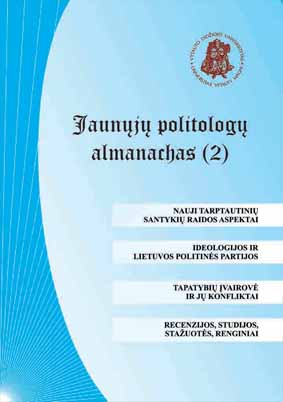Saugumo dinamika Pietų Azijos regioniniame saugumo komplekse
Security Dynamics within South Asian Regional Security Complex
Author(s): Ieva KarpavičiūtėSubject(s): Politics / Political Sciences
Published by: Vytauto Didžiojo Universitetas
Keywords: saugumas; dinamika; regionas; Pietų Azija; secutiry; dinamics; region; South Asia
Summary/Abstract: Straipsnyje analizuojant Pietų Azijos regioninę saugumo dinamiką, taikomos Regioninių saugumo kompleksų, saugumizacijos, naujojo regionalizmo teorijos bei saugumo bendrijos teorinės prielaidos. Pagrindžiama, jog jas derinant galima suformuoti pagrindus saugumo grėsmių dinamikos analizei regioniniame lygmenyje. Saugumo grėsmių analizės regioniniame lygmenyje galimybės konstruojamos, įtraukiant postmodernų diskursinį saugumo suvokimą, objektyvistinio suvokimo derinimą su subjektyvistiniu bei bandant derinti tradicinį bei naująjį, platesnį požiūrį į saugumą. The purpose of this article is the analysis of security situation in the South Asian region. It is constructed by using the combination of three theories – Regional security complex, Securitization, and New regionalism. The combination of those theories forms the basis for security analysis within the region. Analysis of security threats is constructed by combining postmodern discursive – subjective and objective security perceptions. The article also takes into consideration the globalization’s impact on transnational security threats within the region. The security dynamics of South Asian regional security complex are determined by historical, geographical, geopolitical, ethnical and religion related aspects. The basic problem that impedes the development of the region, and determines security dynamics – is conflicts within South Asia. Those conflicts are followed by vast flows of refugees, and tensions among regional countries. South Asia is a standard regional security complex with the bipolar division of power between India and Pakistan. The level of regional security complex is strongly determined by Kashmir’S conflict that gives the key feature for regional transformation to a higher level of regioness - regional society. Obviously the elimination of tensions between those two countries would strengthen the regionalization processes. The possible transition from standard to central regional security complex is also determined by India’s ambitions, outward orientation and weakness of Pakistan. In South Asian regional security complex exist traditional model of power balance and an anarchic structure, that means that countries have securitized each other as potential security threats and there are no clear improvements towards cooperation in security sphere (except economic cooperation). Because of high intensity of conflicts within the region, there is no attention drawn to transnational security threats, with an exception of terrorism that is prompted by world’s leading superpower - the United States. India securitizes the new security threats but prevention of them is transferred from regional to a higher – system level - as a support to the USA in a global war on terrorism. By doing so India expects to get a higher status within international community. Transnational threats in this region are not perceived as common regional problems.
Journal: Politikos mokslų almanachas
- Issue Year: 2006
- Issue No: 02
- Page Range: 46-79
- Page Count: 34
- Language: Lithuanian

